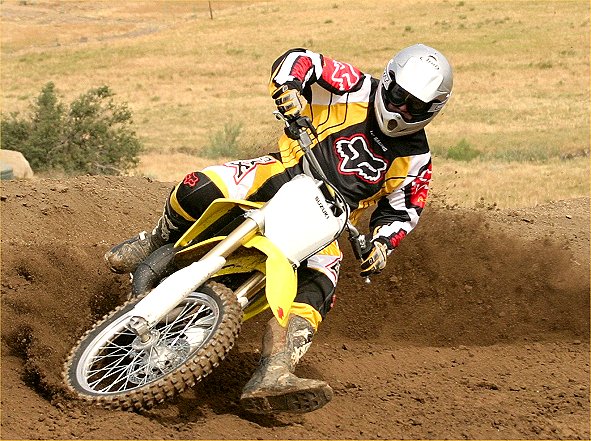
The 2004 RM125 Is a Nimble Machine
Suzuki Motocross/Supercross Team Manager Roger DeCoster has had more than his share of trouble . . . lots more. The injury rate of his talented core of riders, including Travis Pastrana, Sebastien Tortelli and Stephane Roncada, among others, has been amazingly high.
All is not bad news for Team Sobe Suzuki, however. By all accounts, the factory Suzuki motocross machines, particularly, the 250cc bike, are among the best on the track. At the World championship level, Mickael Pichon has taken an RM250 to two straight titles, and a 12 race win streak. The race bikes are very good, indeed.
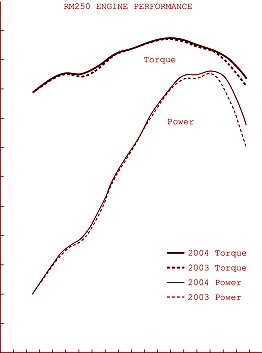 |
|
The 250 has More Power Everywhere for ’04 |
The good news continues for Suzuki in the showroom. Although Suzuki has always produced a competitive 125cc motocross machine, the 250cc machine did not get much respect until a few years ago. The 250 has been on an upward curve, in terms of rider/customer respect, ever since. We got a chance to test the 2004 RM125 and RM250 recently, with other members of the press, at Cahuilla Creek Motocross Park here in Southern California. Both of these bikes received significant changes for 2004.
Indeed, listing all of the changes to the full size Suzuki two-stroke motocrossers this year is difficult, if not impossible. We will focus on the most significant changes.
The RM250 had a good motor last year. It had good low-end, and a solid midrange hit, but not a lot of over-rev. For 2004, Suzuki somehow managed to retain all of the low-end (enhance it, in fact) and give the RM250 more upper midrange and over-rev. Take a look at the torque and horsepower curve comparisons provided by Suzuki. Our time in the saddle of the 2004 RM250 backs up Suzuki’s engine performance claims (more about that later in this article).
The changes to the RM250 engine include a reshaped cylinder head with tighter squish band, repositioned and reshaped sub-exhaust ports, revised timing for the control cams that open/close the sub-exhaust ports, and a higher spring rate for the governor that controls the actuator rod on the main exhaust valve. These changes combined with a reshaped piston ring, increased crank inertia and a special technique for balancing the crank.

2004 RM250
Indeed, I found most interesting the decision by Suzuki engineers to purposely leave the crank slightly out of balance. Suzuki’s press materials state the following about this aspect of the 2004 RM250 engine design. “On a micro level, the result is a slight imbalance, producing a tiny vibration in the phasing of the power pulses reaching the rear tire. On a macro level, however, a rider doesn’t feel any additional vibration, but can feel a noticeable increase in traction under acceleration.” On the track, this seemed to work, as the 2004 RM250 hooked up remarkably well, without having an overly heavy flywheel (although, crank inertia is increased slightly for 2004, by 1.4%).
The 2004 RM250 also has some jetting changes to the carburetor (the bike we rode was jetted perfectly), and some refinements to the transmission, to improve shifting.
Other significant changes to the 2004 RM250 concern the frame and rider ergonomics. The stock frame gusset near the steering head has been made thicker, to increase its rigidity and improve straight-line stability. Ergonomics were adjusted by moving the foot pegs back 10mm, lowering the seat height by 10mm, reshaping the seat, and raising the handlebars by 7mm.
For 2004, the RM250 also receives Showa suspension components (replacing last years Kayaba units). The front fork features 47mm tubes, offering greater rigidity, and a higher spring rate than last year’s units. Interestingly, Suzuki also changed the fork offset this year — now at 22.5 mms offset, rather than last year’s 24.5 mms. Both the Suzuki motocross/supercross teams, and the Suzuki off-road teams had been running reduced-offset triple clamps in prior years, and now the stock machine comes with this feature. This places more weight on the front wheel, and effectively improves cornering performance without a negative impact on high-speed stablity.
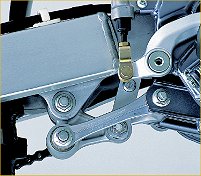 |
|
New Shock Linkage Design |
The new Showa shock works through a new linkage system incorporated into all of the large Suzuki motocross bikes. This new linkage system is smoother and more progressive, with the positioning of the link rod and shock rod reversed when compared to the 2003 design. For 2004, the shock link is connected to the swingarm (rather than the frame) and the link rod is connected to the frame (rather than the swingarm). This results in the primary rear shock loads being absorbed by the swingarm rather than the frame, allowing the frame to be lighter. It also means the rear shock moves in an outward arch when compressed, rather than forward and backward, which improves rear wheel traction, particularly, while accelerating.
The brakes on both RMs also feature significant updates. Most noticeable is the direct routing of the front brake line (Honda-style) for 2004. What you don’t see is a newly designed front brake master cylinder, a redesigned piston seal behind the front brake caliper, and a floating (two-piece) front disk. Together, these changes are designed to improve the power and feel of Suzuki’s front brake, and reduce disk warpage and alignment problems. Out back, the primary change to the rear brake involves an integration of the brake fluid reservoir tank with the master cylinder body (something Honda and Kawasaki have already incorporated on their production machines).

2004 RM125
Finally, Suzuki offers a manual clutch adjustment feature, allowing the rider to adjust free play instantly, even while racing.
Switching our attention to the RM125, the changes for 2004 are no less significant. The Showa suspension, and linkage changes, described for the RM250 apply to the RM125 for 2004, as well. Ditto for the braking system changes, and the manually adjustable clutch. The unique changes to the RM125 concern the engine and chassis.
For 2004, Suzuki engineers have tried to increase midrange and high rpm output in the RM125, while minimizing loss of low-end engine performance. To do so, Suzuki incorporates a flat-top piston this year, and a reshaped combustion chamber. Additionally, the main exhaust port and boost scavenging ports where reshaped, and new sub-exhaust ports were added on both sides of the main exhaust port. Those new sub-exhaust ports each have a valve linked to the main exhaust valve.
 |
|
Both RMs Felt Balanced in the Air |
The 125 receives a significant, 6.5% increase in crank inertia, and utilizes an 8mm longer connecting rod versus 2003. The stock air filter also receives larger mesh size, to improve engine breathing.
Finally, the seat height of the 2004 RM125 is 10mm lower than the 2003 model.
Now that we have thoroughly bored you with all the technical details, what is it like to ride the 2004 RMs? Let’s begin with the 2004 RM250.
Our first impression of the 2004 RM250 is that it is one of the best, box stock 250cc two-stroke motocross bikes ever made. That is quite a statement, but the RM250 was extremely impressive during our day aboard the machine at Cahuilla Creek. Beginning with the engine, Suzuki engineers did a fantastic job. Everyone has been raving about the Yamaha YZ250 engine for the last couple of years, and Suzuki seems to have found a similar formula.
The ’04 RM250 pulls very strongly, but smoothly, off the bottom, and revs hard through the midrange and into a very potent top-end. It has one of the broadest stock 250cc powerbands we can recall, and it delivers that power smoothly and usably.
That slight increase in crankshaft inertia, and the slight imbalance purposely engineered into the RM250 crank, together with the redesigned rear shock linkage, result in a bike that hooks up extremely well while accelerating out of corners. Indeed, acceleration bumps and braking bumps are handled very well by the fork and the shock.
The ergonomic tweaks to the RM250 made the bike comfortable from the moment I got on it. Some bikes don’t feel right, particularly, when you first ride them. The 2004 RM250 felt right immediately, and only felt better as the day went on.
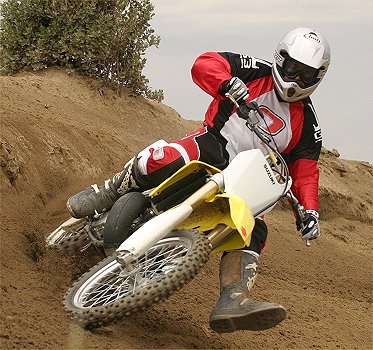
At approximately 200 pounds with my gear on, I had the Suzuki mechanics dial in a bit more rear spring preload, and rode the RM250 with 100 mm of sag. The stock spring rate seemed to handle my weight just fine on this track, and the valving of the suspension felt very good.
The bottom line is that the 2004 RM250 is very easy to ride, feels perfectly balanced and is very confidence-inspiring. Don’t be surprised if the Suzuki RM250 contends for the top spot in shootouts with various print magazines this year.
The RM125 was also difficult to fault from a handling perspective. Those same Showa suspension components found on the RM250 do an equally admirable job on the RM125. The RM125 for 2004 also has a very potent midrange motor. There isn’t much low-end to speak of, but the midrange comes on hard and pulls into a decent top-end. Frankly, I think Suzuki had some trouble jetting the RM125 for the Cahuilla Creek introduction, and I can understand why. The introduction was held at 4,000 feet above sea level, and the RM125 was tested on a day that featured unusual humidity levels. The bike ran well, but, I suspect, not at its best.
The new brakes on both the RM250 and RM125 did their job very well, and there are no complaints in this category following our first impression. The front brake, in particular, felt smooth, progressive, and powerful.
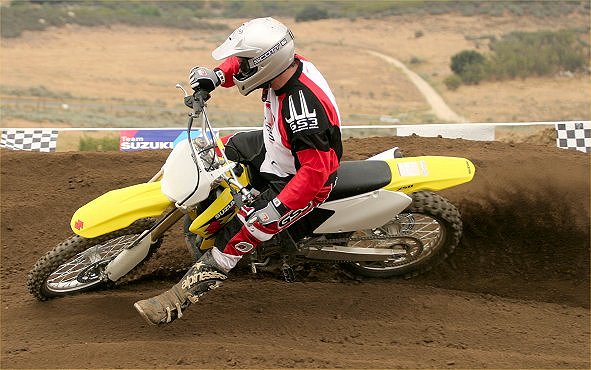
The 2004 RM250 is a Great Package
All in all, Suzuki took huge steps forward with both the RM250 and the RM125 for 2004, with the RM250 being a particular stand out.
The 2004 RM125 retails for $5,099, while the U.S. MSRP of the 2004 RM250 is $5,999. Check Suzuki’s website, and check with your dealer, for details regarding Suzuki’s Racer Contingency Program (one of the best in the industry), free Tony D. Motocross Schools and RM purchase promotions (ask your dealer about a free Makita cordless impact driver with socket set, free gear bag, etc.).





